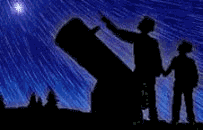

 |
 |
| A Guide to find the right telescope and other neat stuff for beginning Amateur Astronomers. |
 |
Understanding telescopes. |
 |
How to find stuff in your telescope. |
 |
Cleaning telescopes. |
 |
Telescope stuff you need. |
 |
How to choose a telescope. |
I want to see everything!
The best overall telescope type you can get is the Schmidt-Cassegrain type. They give good overall performance, are the most compact and the easiest to transport, and can be purchased with many features such as computerized star tracking. Unfortunately they are expensive too.
Astronomy Magizine's
Backyard Astronomer
Sky and Telescope Magazine'S
Tips on Telescopes
How to Choose a Quality Telescope for Under $500.00
You can get an computer program that can give you up to date charts for your area. The price for these can range from FREE to more than $500.00. The free one is highly recommended it main draw back is you can't print the charts. Find it at www.fourmilab.ch/. I use Earth Centered Universe (ECU) by David Lane. It creates great charts, has a lot of features, and is VERY reasonably priced. You can down load a shareware version at www.nova-astro.com. The next thing you need is a good star map, book, or Atlas (kind of like a book of city street maps but for stars). They will show you most of the brighter stars that you see in your telescope. That will help you find faint objects.
A subscription to Astronomy and/or Sky and Telescope Magazine is VERY useful (and interesting). They will tell you where the planets are for that month, whats new, plus a whole bunch more. (must get at least one of them.)
I recommend that you get both a reflex finder and a finder
scope. If you are on a tight budget get the Reflex type finder.
When you get (or upgrade) a finder scope get one at least 30mm
in diameter. Get a bigger one if you have a telescope larger than
60MM and can afford it.
None of them are absolutely necessary EXCEPT the solar filter if you want to explore the Sun. Never get the type of solar filter that attachs to the eyepiece. If you have one that came with your scope - throw it away. These filters are very close to where the main lens(mirror) focuses (focal point) and the intense heat can cause the filter to break while viewing. This will FRY your eye before you can pull it away. I had this happen to me, fortunealty I was not looking through the eyepiece then. I recommend getting the filters that will fit your viewing habits and solve your problems.
Want to how to figure out what power your eyepiece will give
you?
First find out what your telescopes focal length(fl) (Focal length
of Main Objective) is. This is usually given in Millimeters(mm).
Then divide that by the focal length of your eyepiece also given
in mm. For example suppose you have a 60mm (2in.) refractor telescope.
you look in the documentation (on the side of some telescopes)
and find that your focal length(fl) is 900mm. You look on the
side of (or on top of) your eyepiece and find you have a 9mm eyepiece.
Now you take 900mm divided by 9mm and get 100x(900/9=100). Your
telescope is a 2 inch (60mm) telescope and you can get 50x - 60x
per inch. That would be your high power eyepiece (the highest
you could go with that telescope would be a 7.5mm - 7mm eyepiece).